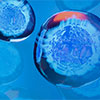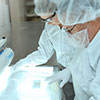BIOTIUM, INC
Supplier:
Biotium
Description:
Goat anti-mouse IgG2a is an affinity-purified antibody that reacts with Fc portion of the heavy chain of mouse IgG2a. To minimize cross reactivity, the antibody is cross-adsorbed against other mouse IgG subclasses (IgG1, IgG2b, IgG3), and human, bovine and rabbit serum proteins. CF™405S is a blue fluorescent dye with an absorption peak wavelength that nearly coincides with the 405 nm blue diode laser line. In addition, the emission peak wavelength of the dye well centers within the blue detection window of BD flow cytometers. As a result, flow cytometry analysis using CF™405S results in much brighter signal compared to Alexa Fluor® 405.
Alexa Fluor® is a registered trademark of Thermo Fisher Scientific.
Supplier:
Biotium
Description:
This conjugate is prepared by labeling F(ab’)2 fragment of goat anti-rabbit IgG (H+L) with CF™568 dye. CF™ dyes offer advantages in brightness, photostability, and specificity compared to other fluorescent dyes. Red fluorescent CF™568 (Ex/Em 562/583 nm) produces much brighter antibody conjugates than Alexa Fluor® 568, and has superior photostability.
Alexa Fluor® is a registered trademark of Thermo Fisher Scientific.
Supplier:
Biotium
Description:
This conjugate is prepared by labeling F(ab’)2 fragment of goat anti-mouse IgG (H+L) with CF™488A dye. CF™ dyes offer advantages in brightness, photostability, and specificity compared to other fluorescent dyes. Green fluorescent CF™488A (Ex/Em 490/515 nm) is a superior alternative to FITC (or fluorescein) owing to its exceptional brightness and photostability.
Alexa Fluor® is a registered trademark of Thermo Fisher Scientific.
Supplier:
Biotium
Description:
Proximal Nephrogenic Antigen / Renal Cell Carcinoma (RCC), Monoclonal antibody, Clone: 66.4.C2, Host: Mouse, Species reactivity: Human, Horse, Isotype: IgG2b, kappa, Conjugate: CF488A, Immunogen: human renal cortical tissue, Size: 100uL
Supplier:
Biotium
Description:
Prolactin Receptor, Monoclonal antibody, Clone: PRLR/742, Host: Mouse, Species reactivity: Human, Isotype: IgG1, kappa, Conjugate: CF647, Immunogen: Semi-purified human prolactin receptor, Application: Immunofluorescence, Flow cytometry, Size: 500uL
Supplier:
Biotium
Description:
This MAb recognizes a 60 kDa antigen associated with the mitochondria in human cells. It is a part of a new panel of reagents, which recognizes subcellular organelles or compartments of human cells. These markers may be useful in identification of these organelles in cells, tissues, and biochemical preparations. It recognizes an antigen associated with the mitochondria in human cells only. It can be used to stain the mitochondria in cell or tissue preparations and can be used as a mitochondrial marker in subcellular fractions. It produces a spaghetti-like pattern in normal and malignant cells and may be used to stain mitochondria of cells in fixed or frozen tissue sections. It can also be used with paraformaldehyde fixed frozen tissue or cell preparations. This MAb is an excellent marker for human cells in xenographic model research. It reacts specifically with human cells, including neurons and embryonic stem cells.
Supplier:
Biotium
Description:
MART-1 / Melan-A, Monoclonal antibody, Clone: M2-7C10, Host: Mouse, Species reactivity: Mouse, Dog, Rat, Human, Isotype: IgG1, kappa, Conjugate: purified, Immunogen: Recombinant hMART-1 protein, Synonyms: Antigen LB39-AA, Antigen SK29-AA, Application: IF, Size: 500uL
Supplier:
Biotium
Description:
Neurofilament (H+L), Monoclonal antibody, Clone: NF421 + NFL736, Host: Mouse, Species reactivity: Mouse, Pig, Rat, Human, Chicken, Isotype: IgG's, Conjugate: CF568, Immunogen: Recombinant human neurofilament heavy sub-unit (RT-97) & light sub-unit (NR-4), Size: 500uL
Supplier:
Biotium
Description:
Neurofilament (H+L), Monoclonal antibody, Clone: NF421 + NFL736, Host: Mouse, Species reactivity: Mouse, Pig, Rat, Human, Chicken, Isotype: IgG's, Conjugate: CF647, Immunogen: Recombinant human neurofilament heavy sub-unit (RT-97) & light sub-unit (NR-4), Size: 100uL
Supplier:
Biotium
Description:
Myogenin, Monoclonal antibody, Clone: MGN185 + F5D, Host: Mouse, Species reactivity: Pig, Dog, Cat, Rat, Human, Isotype: IgG2a, kappa, Conjugate: CF640R, Immunogen: Rat myogenin peptide (aa 73-94), recombinant fragment (aa30-224), Synonym:cb553, Size: 100uL
Catalog Number:
(75967-844)
Supplier:
Biotium
Description:
This antibody recognizes a protein of 57 kDa, identified as p57Kip2. It shows no cross-reaction with p27Kip1. p57Kip2 is a potent tight-binding inhibitor of several G1 cyclin complexes, and is a negative regulator of cell proliferation. Anti-p57 has been used as an aide in identification of complete hydatidiform mole (CHM) (no nuclear labeling of cytotrophoblasts and stromal cells) from partial hydatidiform mole (PHM) in which both cytotrophoblasts and stromal cells stain. The histological differentiation of complete mole, partial mole, and hydropic spontaneous abortion is problematic. Most complete hydatidiform moles are diploid, whereas most partial moles are triploid. Ploidy studies will identify partial moles, but will not differentiate complete moles from non-molar gestations. Complete moles carry a high risk of persistent disease and choriocarcinoma, while partial moles have a very low risk. In normal placenta, many cytotrophoblast nuclei and stromal cells are labeled with this antibody. Similar findings apply to PHM and hydropic abortus tissues. Intervillous trophoblastic islands (IVTIs) demonstrate nuclear labeling in all three entities and serve as an internal control.
Supplier:
Biotium
Description:
P27 / KIP1, Monoclonal antibody, Clone: SX53G8, Host: Mouse, Species reactivity: Mouse, Monkey, Rat, Human, Isotype: IgG's, Conjugate: CF594, Immunogen: Mouse recombinant p27 protein (DCS-72.F6), Synonyms: Cyclin Dependent Kinase Inhibitor 1B, Application: IF, Size: 500uL
Supplier:
Biotium
Description:
Pax genes contain paired domains with strong homology to genes in Drosophila, which are involved in programming early development. Lesions in the Pax-6 gene account for most cases of aniridia, a congenital malformation of the eye, chiefly characterized by iris hypoplasia, which can cause blindness. Pax-6 is involved in other anterior segment malformations besides aniridia, such as Peters anomaly, a major error in the embryonic development of the eye with corneal clouding with variable iridolenticulocorneal adhesions. The Pax-6 gene encodes a transcriptional regulator that recognizes target genes through its paired-type DNA-binding domain. The paired domain is composed of two distinct DNA-binding subdomains, the amino-terminal subdomain and the carboxy-terminal subdomain, which bind respective consensus DNA sequences. The human Pax-6 gene produces two alternatively spliced isoforms that have the distinct structure of the paired domain.
CF® dyes are Biotium's next-generation fluorescent dyes. CF®640R is a far-red fluorescent dye (Ex/Em 642/662 nm) with excellent brightness, and the best photostabiity among spectrally-similar dyes.
Supplier:
Biotium
Description:
Twenty human keratins are resolved with two-dimensional gel electrophoresis into acidic (pI 6.0) subfamilies. This antibody cocktail recognizes acidic (Type I or LMW) and basic (Type II or HMW) cytokeratins, with 67 kDa (CK1); 64 kDa (CK3); 59 kDa (CK4); 58 kDa (CK5); 56 kDa (CK6); 55 kDa (CK7); 52 kDa (CK8); 56.5 kDa (CK10); 53 kDa (CK13); 50 kDa (CK14); 50 kDa (CK15); 48 kDa (CK16); 46 kDa (CK17); 45 kDa (CK18) and 40 kDa (CK19). Many studies have shown the usefulness of keratins as markers in cancer research and tumor diagnosis. KRT-PAN is a broad spectrum anti pan-cytokeratin antibody cocktail, which differentiates epithelial tumors from non-epithelial tumors e.g. squamous vs. adenocarcinoma of the lung, liver carcinoma, breast cancer, and esophageal cancer. It is useful in characterizing the source of various neoplasms and to study the distribution of cytokeratin containing cells in epithelia during normal development and during the development of epithelial neoplasms. This antibody stains cytokeratins present in normal and abnormal human tissues and shows high sensitivity in the recognition of epithelial cells and carcinomas.
CF® dyes are Biotium's next-generation fluorescent dyes. CF®543 is an orange fluorescent dye (Ex/Em 541/560 nm) designed for the 543 nm laser line. It yields the brightest conjugates among spectrally similar dyes.
Supplier:
Biotium
Description:
This MAb reacts with a protein of 20-30 kDa, identified as PGP 9.5, also known as ubiquitin carboxyl-terminal hydrolase-1 (UCHL-1). Initially, PGP 9.5 expression in normal tissues was reported in neurons and neuroendocrine cells but later it was found in distal renal tubular epithelium, spermatogonia, Leydig cells, oocytes, melanocytes, prostatic secretory epithelium, ejaculatory duct cells, epididymis, mammary epithelial cells, Merkel cells, and dermal fibroblasts. Furthermore, immunostaining for PGP 9.5 has been shown in a wide variety of mesenchymal neoplasms as well. A mutation in PGP 9.5 gene is believed to cause a form of Parkinson's disease.
CF® dyes are Biotium's next-generation fluorescent dyes. CF®568 is a red fluorescent dye (Ex/Em 562/583 nm) with superior brightness and photostability. It also is compatible with super-resolution imaging by STORM and TIRF.
Supplier:
Biotium
Description:
PDCD-1 (programmed cell death-1 protein), also designated CD279, is a type I transmembrane receptor and a member of the immunoglobin gene superfamily. It is expressed on activated T-cells, B-cells, and myeloid cells. Anti-PDCD-1 is a marker of angioimmunoblastic lymphoma and suggests a unique cell of origin for this neoplasm. Unlike CD10 and BCL6, PDCD-1 is expressed by few B-cells, so anti-PDCD-1 may be a more specific and useful diagnostic marker in angioimmunoblastic lymphoma. In addition, PDCD-1 expression provides evidence that angioimmunoblastic lymphoma is a neoplasm derived from germinal center-associated T-cells.
CF® dyes are Biotium's next-generation fluorescent dyes. CF®640R is a far-red fluorescent dye (Ex/Em 642/662 nm) with excellent brightness, and the best photostabiity among spectrally-similar dyes.
Inquire for Price
Stock for this item is limited, but may be available in a warehouse close to you. Please make sure that you are logged in to the site so that available stock can be displayed. If the
Stock for this item is limited, but may be available in a warehouse close to you. Please make sure that you are logged in to the site so that available stock can be displayed. If the
You must log in to order restricted items. We request that you provide the required business documentation to purchase this product for the first time.
To order chemicals, medical devices, or other restricted products please provide identification that includes your business name and shipping address via email CMD_NA@vwr.com or fax 484.881.5997 referencing your VWR account number . Acceptable forms of identification are:
-Additional Documentation May be needed to purchase this item. A VWR representative will contact you if needed.
This product has been blocked by your organization. Please contact your purchasing department for more information.
The original product is no longer available. The replacement shown is available.
This product is currently unavailable but limited stock may be available in our extended warehouse network. Please call 1-800-932-5000 and a VWR Customer Service Representative will help you.
|
|||||||||


































